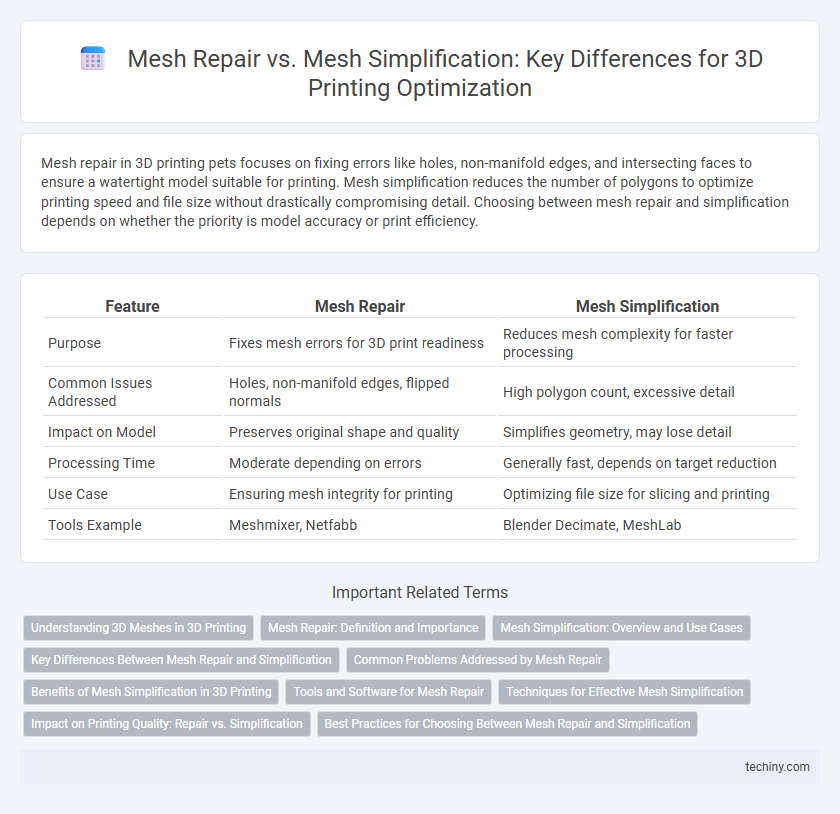Mesh repair in 3D printing pets focuses on fixing errors like holes, non-manifold edges, and intersecting faces to ensure a watertight model suitable for printing. Mesh simplification reduces the number of polygons to optimize printing speed and file size without drastically compromising detail. Choosing between mesh repair and simplification depends on whether the priority is model accuracy or print efficiency.
Table of Comparison
| Feature | Mesh Repair | Mesh Simplification |
|---|---|---|
| Purpose | Fixes mesh errors for 3D print readiness | Reduces mesh complexity for faster processing |
| Common Issues Addressed | Holes, non-manifold edges, flipped normals | High polygon count, excessive detail |
| Impact on Model | Preserves original shape and quality | Simplifies geometry, may lose detail |
| Processing Time | Moderate depending on errors | Generally fast, depends on target reduction |
| Use Case | Ensuring mesh integrity for printing | Optimizing file size for slicing and printing |
| Tools Example | Meshmixer, Netfabb | Blender Decimate, MeshLab |
Understanding 3D Meshes in 3D Printing
Mesh repair in 3D printing involves fixing errors like holes, non-manifold edges, and intersecting faces to ensure the model is printable and structurally sound. Mesh simplification reduces the polygon count by removing redundant vertices and faces, optimizing the file size and print speed without significantly compromising detail. Understanding these processes is crucial for manipulating 3D meshes effectively to produce accurate and efficient prints.
Mesh Repair: Definition and Importance
Mesh repair in 3D printing involves detecting and fixing errors in a digital mesh model, such as holes, non-manifold edges, and flipped normals, to ensure printability and structural integrity. This process is crucial because faulty meshes can lead to printing failures, wasted materials, and weakened final parts. Ensuring a clean, error-free mesh enhances the accuracy and reliability of the 3D printed object, preventing costly delays and maintaining design fidelity.
Mesh Simplification: Overview and Use Cases
Mesh simplification reduces the polygon count of 3D models to optimize printing time and material usage without significantly compromising detail. Common use cases include preparing complex scans for easier processing, improving performance in real-time visualization, and minimizing file sizes for smoother workflow integration. This technique is essential in 3D printing when balancing model accuracy with efficiency constraints.
Key Differences Between Mesh Repair and Simplification
Mesh repair in 3D printing involves fixing errors such as holes, non-manifold edges, and intersecting faces to ensure the model is watertight and printable, while mesh simplification reduces the polygon count to optimize file size and improve print speed, often at the cost of detail. Repair prioritizes geometric accuracy and model integrity by correcting defects without altering the overall shape, whereas simplification focuses on balancing detail and performance by removing unnecessary vertices and faces. Understanding these differences is crucial for preparing 3D models that are both structurally sound and efficient for printing workflows.
Common Problems Addressed by Mesh Repair
Mesh repair in 3D printing addresses common problems like non-manifold edges, holes, intersecting faces, and inverted normals that can cause print failures or structural weaknesses. It ensures the model is watertight and error-free, essential for successful slicing and printing processes. By correcting corrupted geometry, mesh repair improves print accuracy and reduces the risk of defects in the final 3D printed object.
Benefits of Mesh Simplification in 3D Printing
Mesh simplification in 3D printing reduces the complexity of models by decreasing polygon count, resulting in faster print times and lower material usage. Simplified meshes improve slicing software performance and ensure smoother surface finishes by minimizing errors caused by overly dense geometry. This process enhances compatibility with various printers and reduces the likelihood of print failures due to intricate mesh details.
Tools and Software for Mesh Repair
Mesh repair in 3D printing focuses on fixing defects such as holes, non-manifold edges, and flipped normals to ensure printability, with tools like Meshmixer, Netfabb, and Microsoft 3D Builder being widely used for automatic and manual corrections. These software solutions provide robust algorithms for detecting and repairing mesh errors, enhancing model integrity before slicing. Compared to mesh simplification, which reduces polygon count for performance optimization, mesh repair ensures the model's structural correctness for successful 3D printing outcomes.
Techniques for Effective Mesh Simplification
Mesh simplification techniques for 3D printing primarily involve algorithms such as Quadric Error Metrics (QEM) that reduce polygon count while preserving visual fidelity, enabling faster printing and reduced material usage. Edge collapse and vertex clustering methods are also popular, offering efficient ways to simplify complex meshes by collapsing edges or merging vertices without significantly altering the model's shape. These techniques improve printability and reduce file sizes, making mesh simplification a critical step before 3D printing intricate designs.
Impact on Printing Quality: Repair vs. Simplification
Mesh repair corrects errors such as holes, non-manifold edges, and intersecting faces, ensuring accurate geometry that prevents print failures and improves dimensional accuracy. Mesh simplification reduces polygon count, which can speed up slicing and printing but may sacrifice detail, potentially lowering surface quality and fine features. Prioritizing mesh repair over excessive simplification maintains print reliability and detail preservation essential for high-quality 3D prints.
Best Practices for Choosing Between Mesh Repair and Simplification
Mesh repair focuses on fixing errors such as holes, non-manifold edges, and intersecting faces to ensure the model is watertight and printable, while mesh simplification reduces polygon count to optimize file size and print efficiency. Best practices dictate choosing mesh repair for critical print reliability and structural integrity, whereas simplification is ideal for improving performance and reducing print time on complex models. Evaluate print requirements, model complexity, and software capabilities before deciding between repair and simplification for optimal 3D printing results.
Mesh Repair vs Mesh Simplification Infographic

 techiny.com
techiny.com